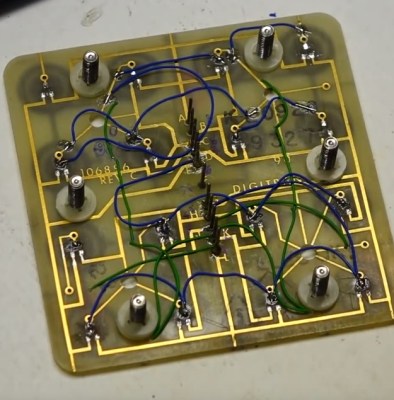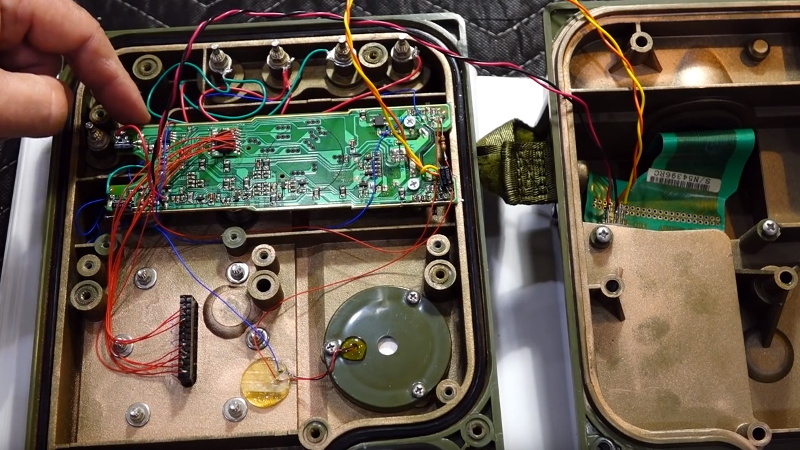After spotting some interesting military phones at a museum, [CuriousMarc] wondered what it would take to retrofit these heavy duty pieces of telecom equipment for civilian use. He knew most of the internals would be a lost cause, but reasoned that if he could reverse engineer key elements such as the handset and keypad, he might be able to connect them to the electronics of a standard telephone. Luckily for us, he was kind enough to document the process.
 There were a number of interesting problems that needed to be solved, but the first and perhaps largest of them was the unusual wiring of the keypad. It wasn’t connected in the way modern hackers like us might expect, and [CuriousMarc] had to end up doing some pretty significant rewiring. By cutting the existing traces on the PCB with a Dremel and drilling new holes to run his wires around the back, he was able to convert it over to a wiring scheme that contemporary touch tone phones could use.
There were a number of interesting problems that needed to be solved, but the first and perhaps largest of them was the unusual wiring of the keypad. It wasn’t connected in the way modern hackers like us might expect, and [CuriousMarc] had to end up doing some pretty significant rewiring. By cutting the existing traces on the PCB with a Dremel and drilling new holes to run his wires around the back, he was able to convert it over to a wiring scheme that contemporary touch tone phones could use.
An adapter needed to be fabricated to mount a basic electret microphone in place of the original dynamic one, but the original speaker was usable. He wanted to adapt the magnetic sensor that detected when the handset was off the hook, but in the end it was much easier to just drill a small hole and use a standard push button.
The main board of the phone is a perfect example of the gorgeous spare-no-expense construction you’d expect from a military communications device, but unfortunately it had to go in the bin. In its place is the guts of a lowly RCA phone that was purchased for the princely sum of $9.99. [CuriousMarc] won’t be able to contact NORAD anymore, but at least he’ll be able to order a pizza. The red buttons on the keypad, originally used to set the priority level of the call on the military’s AUTOVON telephone network, have now been wired to more mundane features of the phone such as redial.
While this is fine for a one-off project, we’d love to see a drop-in POTS or VoIP conversion for these phones that didn’t involve so much modification and rewiring. Now that we have some documentation for things like the keypad and hook sensor, it shouldn’t be hard to take their idiosyncrasies into account with a custom PCB. Dragging vintage gear into the modern era is always a favorite pastime for hackers, so maybe somebody out there will be inspired to take on the challenge.
















It is too bad to ruin an expensive set of these telephones. They are designed to be networked and switched but most importantly can be run on sound power alone. I recall they run at something like 1800ohm or even far above as the high impedance means you could for instance clip into an insulated barbed wire fence and ground to make a phone network as I recall in a HAD article a few years ago. I believe the standard field telephone also has an adapter to jack directly into PSTN as needed but with the call priority keys, the spec is super flexible as I recall.
They’re not expensive any more, they’re only like $70 on eBay, and there seem to be a lot of them.
I suspect it has been superceded by new tech.
This is the digital version of the old analog phones. The digital ones need to hook up to a switch. Even the later analog ones weren’t sound powered (they required batteries for the DTMF keypad.) The Israelis were one of the last users of the the analog ones and you used to be able to find them on eBay with Hebrew keypads (the keypads on all these phones are 4×4 so you can enter your call priority when you dial the number.)
First let me say this is an awesome mod-job! It’s nice to see hacks like this because they inspire others to do more!
That being said…
.Next design might want to forgo the POTs conversion, that technology is almost as dead as rotary dialing! I’d dig a Bluetooth desk phone conversion, so it would act as a handset when it was in range.
Alternatively adding WiFi or Ethernet and going full on VOIP.
Lastly there HAS to be a less invasive way of doing this, something that doesn’t kill the original functionality.
Where there is a problem, a hacker, and a microcontroller there IS a way!!!
The original functionality was killed when it was removed from access to the military telecom systems.
Also he specifically wanted to replace a landline at home, so…
Well it is a field phone, maybe make it a cell phone and take it out into a field.
How could the Military mess up a simple 3 by 4 matrix? Oh boy security thru obfuscation, that and lotsa tax money.
I have a couple of mid century Bakelite phones that I hacked 90’s electronic mics and networks in, instead of those carbon mic-noisemakers. They get daily store use, yes they have dials.
Probably it drives a tone generator directly. Each button enables two tones via the diode. Low tech but functional solution.
It does seem curious that they wouldn’t have just borrowed the de-facto standard way of doing things, no prizes for reinventing the wheel; but I have to wonder how much they would have saved by doing so:
Especially for low complexity stuff like a 3×4 keypad the major savings of “do it the standard way stupid” are that you can buy an off-the-shelf module that does it the standard way and slot it right in; and thanks to economies of scale the ready-to-go 3×4 module costs less than half the buttons you’d need to build your own keypad.(unlike in the case of something like software, where the greater complexity makes reinventing the wheel without cause and care downright dangerous)
If, though, you are required to ensure that the keypad is certified against assorted brutal ingress, shock resistance, ESD, etc. standards I assume that you have substantially fewer and more expensive off-the-shelf options. Probably not zero; but markedly fewer.
Does anyone know how much of a sacrifice going nonstandard would have been in the context of a project where any off-the-shelf parts would have had to be subject to stringent requirements?
What’s that desoldering tool he used?
Hakko FR300 desoldering gun. I can’t say enough good things about it.